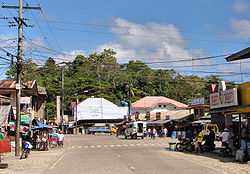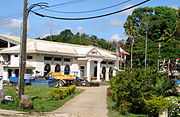Sagbayan, Bohol
| Sagbayan | |
|---|---|
| Municipality | |
 | |
 | |
.svg.png) Sagbayan | |
| Coordinates: 09°55′N 124°06′E / 9.917°N 124.100°ECoordinates: 09°55′N 124°06′E / 9.917°N 124.100°E | |
| Country | Philippines |
| Region | Central Visayas (Region VII) |
| Province | Bohol |
| District | 2nd district of Bohol |
| Incorporated | February 9, 1949 |
| Barangays | 24 |
| Government[1] | |
| • Mayor | Ricardo L. Suarez |
| Area[1] | |
| • Total | 96.75 km2 (37.36 sq mi) |
| Population (2010)[2] | |
| • Total | 20,091 |
| • Density | 210/km2 (540/sq mi) |
| Time zone | PST (UTC+8) |
| ZIP code | 6331 |
| Dialing code | 38 |
| Income class | 5th class |
Sagbayan is a fifth class municipality in the province of Bohol, Philippines. According to the 2010 census, it has a population of 20,091 people.[2]
Its main attraction is Sagbayan Peak, which is an observation platform and children's playground overlooking a scenic valley. While some similar hill formations are visible, it is not within the main Chocolate Hills area.
Sagbayan means "place for hanging", coming from the root word sagbay, which means "to hang" and referred to the practice of hanging deer hides on trees to dry after hunting expeditions.[1]
Barangays
Sagbayan is politically subdivided into 24 barangays.
- Calangahan
- Canmano
- Canmaya Centro
- Canmaya Diot
- Dagnawan
- Kabasacan
- Kagawasan
- Katipunan
- Langtad
- Libertad Norte
- Libertad Sur
- Mantalongon
- Poblacion
- Sagbayan Sur
- San Agustin
- San Antonio
- San Isidro
- San Ramon
- San Roque
- San Vicente Norte
- San Vicente Sur
- Santa Catalina
- Santa Cruz
- Ubojan
History
Sagbayan was formerly part of the surrounding municipalities of Clarin, Inabanga, Carmen, and Balilihan. It was formed into a separate town by an Executive Order of President Elpidio Quirino on February 9, 1949, and named Borja, in honor of Salustiano Borja, the first elected civil governor of the Province of Bohol.[1] It reverted to its original name in 1957.[3]
On October 15, 2013, Sagbayan was the epicenter of an earthquake with a magnitude of 7.2 Mw. The town suffered 12 fatalities and damage to almost 1,000 homes, including total destruction of its town hall.[4]
Demographics
| Population census of Sagbayan | ||
|---|---|---|
| Year | Pop. | ±% p.a. |
| 1990 | 15,364 | — |
| 1995 | 16,488 | +1.42% |
| 2000 | 18,346 | +2.16% |
| 2007 | 19,399 | +0.80% |
| 2010 | 20,091 | +1.18% |
| Source: National Statistics Office[2][5] | ||
Gallery
-

Municipal Building (totally damaged in the 2013 earthquake)
-

Sagbayan Peak
-

View of the Chocolate Hills from Sagbayan Peak
See also
References
- ↑ 1.0 1.1 1.2 1.3 "Municipality of Sagbayan". Province of Bohol. Retrieved 2012-09-20.
- ↑ 2.0 2.1 2.2 "Population and Annual Growth Rates by Province, City, and Municipality - Region VII - Central Visayas: 1990, 2000, and 2010". National Statistics Office.
- ↑ "An Act Changing the Name of the Municipality of Borja, Province of Bohol, to Sagbayan". LawPH.com. Retrieved 2011-04-12.
- ↑ "SitRep No. 35 re Effects of Magnitude 7.2 Sagbayan, Bohol Earthquake". National Disaster Risk Reduction and Management Council. November 3, 2013. Retrieved November 7, 2013.
- ↑ National Statistics Office - Population and Annual Growth Rates by Province, City and Municipality: Central Visayas: 1995, 2000 and 2007
External links
- Sagbayan
- Sagbayan.org
- Municipality of Sagbayan
- Philippine Standard Geographic Code
- Philippine Census Information
- Sagbayan Peak Viewdeck - overlooking Chocolate hills
 |
Inabanga | Danao |  | |
| Clarin | |
Carmen | ||
| ||||
| | ||||
| Catigbian | Batuan |